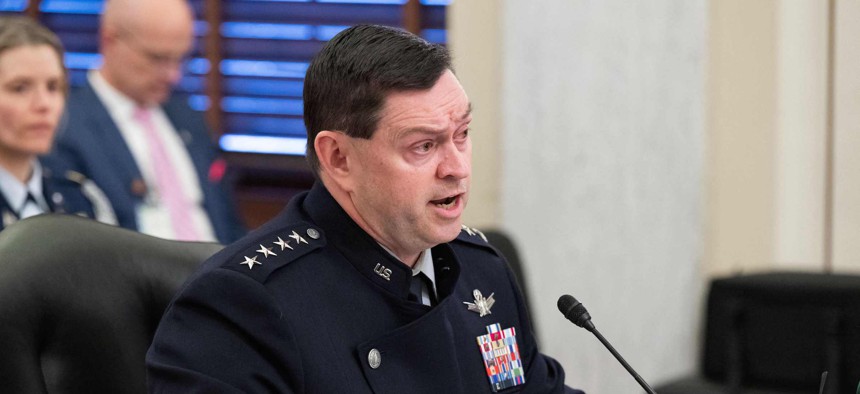Space Force is building a virtual training ground for space conflict

Gen. Chance Saltzman, Chief of Space Operations, testifies about the 2024 budget request on Capitol Hill in Washington, D.C., on March 14, 2023. Saul Loeb/AFP via Getty Images
In an interview, chief of space operations notes China’s efforts to jam and intercept orbiting satellites.
The U.S. Space Force is building a virtual environment to teach its guardians how to fight enemy attempts to thwart its missions in space.
Chief of Space Operations Gen. Chance Saltzman said adversaries are now trying to take away capabilities that the Space Force provides to the U.S. military, such as satellite communications, missile warning, and intelligence, surveillance, and reconnaissance in space.
China has the “capability and demonstrated intent” to conduct counter-space operations and attack U.S. spacecraft, Saltzman said in an interview as part of Defense One's annual State of Defense series.
China does this in a few ways—jamming satellites, launching missiles to hit satellites, and interfering “on orbit,” Saltzman said. Last year, China used a satellite robotic arm to grab another satellite and pull it out of its orbit.
“The Space Force has been stood up to protect those capabilities, and also protect the joint force from an emerging set of capabilities that the adversary is putting on orbit to threaten and target our joint forces on air, land, and sea,” he said.
Saltzman said when he was first trained to fly satellites, the focus was learning how to operate the satellites safely and efficiently.
“I didn't really train against an adversary that was trying to destroy my satellite or deny its capabilities. That really just wasn't required,” he said.
But now, the Space Force is building a virtual environment for its guardians to practice not only how to operate satellites but also “the tactics that would fight off an adversary’s attempts to try to deny us our missions,” he said.
About $340 million of the service’s $30 billion 2024 spending request is slated for building operational testing and training infrastructure.
The request also funds work on two “critical elements” of Joint All-Domain Command and Control, or JADC2, the Pentagon’s effort to weave every military sensor into a unified network.
Saltzman said their “most crucial” contribution to JADC2 is a space data-transport layer, which the Space Development Agency is putting together, to give the U.S. military the ability to move data globally.
The Space Force is also working on a “C2 element” for its own systems and capabilities, Saltzman said.
“We also have to command and control our capabilities, have situational awareness, be able to make operational decisions on a relevant timeline, and then direct forces in a contested environment. And that space C2 element is also a critical contribution that we're making so that we can be tied into the joint force,” he said.
Saltzman said the force aims to put its C2 building blocks in place and roll out some of this software “in the next two to three years.”
With a budget request heavily focused on research and development—to the tune of 65%—Saltzman said he’s focused on threats that will be challenging the Space Force three to five years from now.
“We have the space warfighting analysis center that does modeling and simulation to look at force design efforts that affect those kinds of timeframes, so that we can make sure we're buying the right kinds of capabilities for emerging and future threats and the future environments,” he said.






